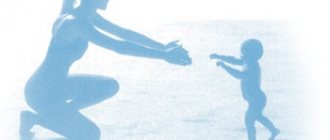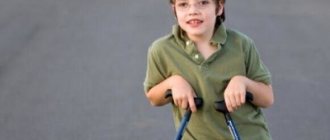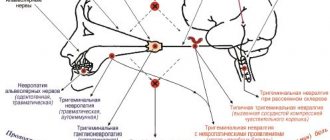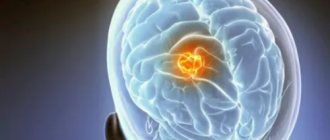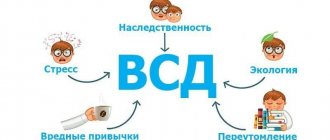Hemiplegic (Hemiparetic) form of cerebral palsy
Right-sided hemiparesis This form is most common. It is expressed in paresis, or paralysis, which covers one half of the body. The arm usually suffers more than the leg. Most patients have mental disorders, reduced intelligence (moronicity, idiocy), but such children are capable of learning and usually adapt to life in society and to work. Children with hemiparesis master age-related skills later than healthy ones. Therefore, the level of social adaptation, as a rule, is determined not by the degree of motor defect, but by the intellectual capabilities of the child. Clinically characterized by the development of spastic hemiparesis (Wernicke-Mann type gait, but without leg circumduction), delayed mental and speech development. Sometimes it manifests itself as monoparesis. With this form, focal epileptic seizures often occur.
Forms of cerebral palsy according to K. A. Semenova
Forms of cerebral palsy according to K. A. Semenova
Terms
Psychological and medical characteristics
Pedagogical characteristics
Recommended educational institution.
Spastic diplegia
Diplegia is a paralysis that affects both sides of the body, more so in the legs than the arms.
Spastic (spasmodic) - occurring during spasms or resembling a spasm in its manifestation.
Praxis (Greek praxis - action). The ability to perform purposeful actions and movements.
Hyperkinesis (Greek hyper- + kinēsis movement) are involuntary movements caused by contraction of the muscles of the face, torso, limbs, less commonly the larynx, soft palate, tongue, and external eye muscles.
Astereognosis is the impossibility or impairment of recognizing an object by touch, without visual control.
Gnosis
(gnosis; Greek gnosis cognition, knowledge) - cognition of objects, phenomena, their meaning and symbolic meaning
It affects more than 50% of patients with cerebral palsy. In spastic diplegia, both the arms and legs are affected, with the lower extremities being more affected than the upper extremities. The degree of damage to the hands varies - from severe paresis to minimal impairment in the form of mild motor awkwardness and impairment of fine differentiated movements of the fingers. The main symptom of spastic diplegia is increased muscle tone in the limbs, limited strength and range of motion in combination with unreduced tonic reflexes. An increase in muscle tone predominates in the adductor muscles of the thighs, due to which there is a crossing of the legs when resting on the toes, which disrupts the support of the feet, posture, and makes standing and walking difficult. With the development of contractures, the limbs can “freeze” in an incorrect position, then movement and manipulation become impossible. The severity of speech, mental and movement disorders varies widely. Mental disorders are found in most children. Most often they manifest themselves in the form of mental retardation, which can be compensated in preschool or primary school age under the influence of classes to correct cognitive impairment. Some children have mental retardation of varying severity. Tonic reflexes disappear in children by 2-3 years, sometimes later. Attitudinal reflexes develop late, after 1.5-2 years, with certain restrictions. Only 20-25% of children move independently (without support or improvised means)
In 70-80% of children with spastic diplegia, speech disorders are noted in the form of spastic-paretic dysarthria, delayed speech development, and, less often, motor alalia. Hyperkinesis of the articulatory and respiratory muscles makes speech slurred and jerky.
Spatial concepts and constructive praxis are impaired. Memory is reduced.
In all forms of cerebral palsy, there is a profound delay and impaired development of the kinesthetic analyzer (tactile and muscle-articular sense). Children find it difficult to determine the position and direction of movements of their fingers without visual control (with their eyes closed). Feeling movements of the hands are often very weak, touch and recognition of objects by touch is difficult. Many children have pronounced astereognosis - the impossibility or impairment of recognizing an object by touch, without visual control. Feeling and manipulation of objects, i.e., effective cognition, are significantly impaired in cerebral palsy.
With spastic diplegia, satisfactory development of verbal and logical thinking is observed with a pronounced lack of spatial gnosis and praxis.
Mental disorders are found in most children. Most often they manifest themselves in the form of mental retardation, which can be compensated in preschool or primary school age under the influence of classes to correct cognitive impairment. Some children have mental retardation of varying severity.
A child suffering from spastic diplegia can learn to care for himself, write, and master a number of work skills. The degree of social adaptation can reach the level of healthy people with intact intelligence and sufficient development of the manipulative function of the hands.
Intelligence in most cases of the disease is reduced. Children have difficulty concentrating in class and quickly become exhausted and distracted. Spatial concepts and constructive praxis are impaired. Memory is reduced. Completing tasks that require the participation of logical thinking and verbal response does not present any particular difficulties for children with this form of cerebral palsy. At the same time, they experience significant difficulties when performing spatial orientation tasks, cannot correctly copy the shape of an object, often mirror asymmetrical figures, and have difficulty mastering the body diagram and direction. These children often have dysfunctions of the counting function, expressed in difficulties in the global perception of quantity, comparison of the whole and parts of the whole, assimilation of the composition of a number, perception of the digit structure of a number and assimilation of arithmetic signs.
Double hemiplegia
HEMIPLEGIA (from the Greek hemi- - semi- and plege - blow, defeat) complete loss of voluntary movements in the arm and leg on one side, paralysis of the right or left half of the body.
Anarthria
(anarthria; an- + Greek arthroo to pronounce articulately) - loss of articulate speech due to paralysis or paresis of the muscles involved in articulation, for example. with bulbar palsy.
This is the most severe form of cerebral palsy, in which there is total damage to the brain, primarily to its cerebral hemispheres. Movement disorders are expressed equally in the arms and legs, or the arms are more affected than the legs. The main clinical manifestations of double hemiplegia are the predominance of muscle rigidity, which increases under the influence of intense tonic reflexes that persist over many years. The righting reflexes are completely or almost undeveloped. Voluntary motor skills are absent or severely limited. Children do not sit, do not stand, do not walk. The function of the hands practically does not develop. Independent movement is impossible. Some children have difficulty mastering the skill of sitting, but even in this case, severe deviations in mental development hinder their social adaptation. All children have severe speech impairments such as anarthria, severe spastic-rigid dysarthria (speech is completely absent or the patient pronounces individual sounds, syllables or words). Thinking is slow, inert, memory is weakened.
.
Speech may also be absent due to the fact that the majority of children (90%) have severe mental retardation. Lack of motivation to activity. In most cases, children with double hemiplegia are unteachable. Severe motor defects of the hands and reduced motivation exclude self-care and simple work activities. Thinking is slow, inert, memory is weakened.
Hemiparetic form
Hemiparetic form. - stiffness of the muscles of the lower and upper extremities on one side (either left or right).
Hemiparesis (hemi + Greek paresis - weakening). Decreased strength and motor activity of the limbs on one side of the body.
This form is characterized by damage to the extremities (arms and legs) on one side of the body. The arm is usually more affected than the leg. Right-sided hemiparesis due to damage to the left hemisphere is observed much more often than left-sided hemiparesis. Depending on the location of the lesion, various disorders may be observed in this form. When the left hemisphere is damaged, speech disorders in the form of motor alalia are often observed, as well as dyslexia, dysgraphia and dysfunction of counting. Each of these disorders can be only partial and manifest itself only in difficulties in learning to read, write, and count. Damage to the temporal regions of the left hemisphere may be accompanied by disturbances in phonemic perception. When the right hemisphere is damaged, pathology of the emotional-volitional sphere is noted in the form of aggressiveness, inertia, and emotional flatness. In severe cases, unilateral restriction of spontaneous movements is noticeable already in the first months of life. Speech pathology is observed in 30-40% of children, most often of the type of spastic-paretic dysarthria or motor alalia.
significantly damaged.
The degree of intellectual impairment varies from mild mental retardation to severe intellectual defect. Moreover, a decrease in intelligence does not always correlate with the severity of motor disorders. The learning ability and level of social adaptation of children with hemiparetic form of cerebral palsy are largely determined not by the severity of motor disorders, but by the child’s intellectual capabilities, timeliness and completeness of compensation for mental and speech disorders.
Significant difficulties in mastering reading (including reading comprehension) and writing in otherwise normal children. A writing disorder in which there are letter substitutions, omissions and rearrangements of letters and syllables, and the merging of words.
Children with right-sided hemiparesis often have opto-spatial dysgraphia. Optical-spatial disturbances appear when reading and writing: reading is difficult and slow, as children confuse letters with similar outlines, and elements of specularity are noted in writing. They develop an idea of the body diagram later than their peers; they do not distinguish between their right and left hands for a long time.
Hyperkinetic form
Hyperkinesis
(hyper + Greek kinesis - movement). Automatic violent movements due to involuntary muscle contractions.
Encephalopathy (encephalopathia, anat. encephalon brain + Greek pathos suffering, disease; synonym: pseudoencephalitis, cerebropathy, encephalosis) is a syndrome of diffuse brain damage of a dystrophic nature, caused by various diseases and pathological conditions.
Hyperkinetic is the sudden appearance of chaotic motor excitation.
Hypotonia (hypotonia; hypo- (Hyp-) + Greek tonos tension, tone). 1) (syn. hypotonicity) - reduced muscle tone or muscle layer
DYSTONIA -i; and. [from Greek dys - non-, un- and tonos - tension] Honey. Increased fatigue of the body, manifested in muscle weakness, insomnia, etc.
The hyperkinetic form of cerebral palsy is associated with damage to the subcortical parts of the brain. The cause is bilirubin encephalopathy (incompatibility of the blood of mother and fetus according to the Rh factor), as well as hemorrhage in the area of the caudate body, which occurs more often as a result of birth trauma. Movement disorders manifest themselves in the form of involuntary violent movements - hyperkinesis. The first manifestations of hyperkinesis begin to appear at 4-6 months. in the muscles of the tongue, and only by 10-18 months. appear in other parts of the body, reaching maximum development by 2-3 years of life. During the neonatal period, decreased muscle tone is noted, later hypotension is gradually replaced by dystonia. Hyperkinesis occurs involuntarily and intensifies with movement and excitement, as well as with fatigue and attempts to perform any motor act. At rest, hyperkinesis decreases and almost completely disappears during sleep. They can cover the muscles of the face, tongue, head, neck, torso, upper and lower extremities. In the hyperkinetic form, voluntary motor skills develop with great difficulty. Children cannot learn to sit, stand or walk independently for a long time. Very late (only at the age of 2-4 years) they begin to hold their head up and sit up. Standing and walking are even more difficult to master. Most often, independent movement becomes possible at 4-7 years of age, sometimes later. The gait in children is usually jerky and asymmetrical. Balance when walking is easily disturbed, but standing still is more difficult for patients than walking. Voluntary movements are sweeping and uncoordinated; automation of motor skills, especially writing skills, is difficult.
Speech disorders are observed in almost all children, most often in the form of hyperkinetic dysarthria. Some children (20-25%) have hearing impairment, especially high-pitched hearing; 10-15% experience seizures. Mental development is less impaired than in other forms of cerebral palsy; in most cases, intelligence develops quite satisfactorily. Mental development disorders such as mental retardation occur in 25% of children
Most children learn to walk independently, but voluntary movements, especially fine motor skills, are significantly impaired.
Prognostically, this is a completely favorable form in relation to learning social adaptation. With moderate movement disorders, children can learn to write and draw. Primary education of children is often carried out at home according to a mass program, less often through an auxiliary program. We get tired quickly.
In such cases, difficulties arise in learning to read and write. When writing from dictation, they make many mistakes. Children have difficulty completing tasks that require verbal processing and are more able to follow visual instructions. The hyperkinetic form of cerebral palsy is characterized by satisfactory development of praxis and spatial gnosis, and learning difficulties are more often associated with speech and hearing impairments.
Atonic-astatic form
The atonic-asthenic form is pronounced lethargy of all muscle groups, leading to impaired movement.
Atony (Greek atonia weakness, powerlessness; a- + tonos tension) - lack of tone.
ASTHENIA (from the Greek astheneia - impotence, weakness) (asthenic syndrome>), a painful condition characterized by increased fatigue, irritable weakness, frequent mood swings, autonomic disorders, sleep disorders.
HYPERMETROPIA (farsightedness), a widespread vision deficiency in which near objects appear blurry.
Tremor (from Latin tremor - trembling) is a fast, rhythmic oscillatory movement of the limbs or torso caused by muscle contractions.
With this form of cerebral palsy, damage to the cerebellum occurs, in some cases combined with damage to the frontal parts of the brain. From the motor sphere, the following are observed: low muscle tone, imbalance of the body at rest and when walking, disturbance of the sense of balance and coordination of movements, tremor, hypermetry (disproportion, excessive movements).
In the 1st year of life, hypotension and a delay in the rate of psychomotor development are detected (control over the position of the head, the functions of sitting, standing and walking are difficult or practically not developed). The functions of grasping and manipulating objects are formed at a later stage and are accompanied by pronounced hand tremors and motor coordination disorders. Sitting develops by 1-2 years, standing and walking - by 6-8 years or later. Motor functions remain imperfect for a long time. The child stands and walks on widely spaced legs, the gait is unsteady and uncertain, the arms are spread to the sides, the body makes many excessive swinging movements in order to maintain balance, the child often falls. All movements are imprecise, disproportionate, their synchrony and rhythm are disturbed. Loss of coordination of fine finger movements and hand tremors make it difficult to perform self-care and master drawing and writing skills. Most children have speech disorders in the form of delayed speech development, ataxic dysarthria; alalia may occur. An important role in the structure of a mental defect is played by the main localization of brain damage, which determines the degree of decline in intelligence. When only the cerebellum is damaged, children have little initiative, many exhibit a fear of falling; the development of reading and writing skills is delayed. If the cerebellar lesion is combined with
damage to the frontal parts of the brain, children experience pronounced underdevelopment of cognitive activity, uncriticality of their defect, disinhibition, and aggressiveness.
In the atonic-astatic form of cerebral palsy, there may be intellectual impairments of varying severity. When only the cerebellum is damaged, children have little initiative. Children have a pronounced underdevelopment of cognitive activity and are uncritical of their defect. Cannot master self-care skills and school skills.
11
Spastic diplegia (Little's syndrome). Tetraparesis with spasticity in the legs.
The most common type of cerebral palsy (3/4 of all spastic forms) is expressed in spastic paresis of mainly the lower extremities. Favorable prognosis for the possibility of social adaptation. The degree of social adaptation with normal mental development can reach the level of a healthy person. Spastic diplegia is characterized by the early formation of contractures, deformities of the spine and joints. Mostly diagnosed in children born prematurely. Pathology of the cranial nerves is common: convergent strabismus, optic nerve atrophy, hearing impairment, delayed mental and speech development, dysarthria, etc., including those caused by environmental influences on the child (insults, segregation). The patient’s psyche suffers, but not as much as in other forms of cerebral palsy. The prognosis for motor abilities is less favorable than for hemiparesis.
Classification of cerebral palsy
For more than a century and a half that have passed since the first description by Little (Little WJ, 1843) of the consequences of birth trauma of the central nervous system and asphyxia during childbirth, more than 20 classifications of diseases have been proposed, which Z. Freud in 1924 called cerebral palsy (Semenova K.A. ., 1999).
In our country in past years, the classification proposed in 1952 by A. Ford and somewhat modified later by D.S. was used. Footer (1958). Subsequent classifications were proposed by K. Bobath and B. Bobath (1964), Phelps (1970).
Currently in the Russian Federation the classification of K.A. is used. Semenova (1974). In 2000, a new international classification of cerebral palsy .
Classification by Semenova K.A.:
1) spastic diplegia; 2) double hemiplegia; 3) hemiparetic form; 4) hyperkinetic form; 5) atonic-astatic form.
International classification of cerebral palsy:
1) spastic form:
- two-sided;
- one-sided;
2) dyskinetic (athetoid) form:
- choreoathetoid;
- dystonic;
3) ataxic form; 4) mixed form.
This classification of cerebral palsy is complemented by the localization of the lesion according to the anatomical principle
- quadraplegia (all four limbs are equally affected),
- diplegia (lower limbs are more affected than upper limbs),
- hemiplegia (both limbs on one side of the body are affected).
The most common are spastic forms of the disease (according to K.A. Semenova): spastic diplegia, spastic hemiparesis, double hemiplegia. They are characterized by impaired muscle tone such as spasticity, increased tendon reflexes, pathological foot signs, a tendency to form pathological postures, deformities and contractures of the joints, pathological synergies and synkinesis.
Normally, in the central nervous system, movement is controlled by three areas of the brain: the motor areas of the cerebral cortex, the basal ganglia, and the cerebellum. From these areas the motor impulse is transmitted to the spinal cord, and from it to the muscles.
When the motor areas of the cortex are damaged, spastic forms of cerebral palsy occur (spastic diplegia, double hemiplegia, hemiparetic form).
When the basal ganglia are damaged, a dyskinetic (hyperkinetic) form of cerebral palsy occurs, and damage to the cerebellum causes an atactic (atonic-astatic) form of cerebral palsy (Table 27).
Table 27
Motor disorders in cerebral palsy
| Violations | Localization of damage |
| Spasticity | I motor neuron (cerebral cortex) |
| Hypotension | II motor neuron (anterior horn of the spinal cord) |
| Dystopia, hyperkinesis | Basal ganglia, thalamus |
| Ataxia | Cerebellum |
Physical rehabilitation of disabled people with lesions of the musculoskeletal system / Ed. S. P. Evseeva, S. F. Kurdybaylo. - M.: Soviet Sport, 2010. - 488 p. Part II. Physical rehabilitation of children suffering from cerebral palsy. Chapter 4. Clinical and functional characteristics of cerebral palsy. pp. 223-224.
Double hemiplegia Spastic tetraplegia
One of the most severe forms of cerebral palsy, which is a consequence of brain damage due to intrauterine chronic fetal hypoxia. The cerebral hemispheres or the entire brain are affected. Spastic quadriplegia (quadriparesis, since both the upper and lower limbs are equally severely affected) is diagnosed clinically. Characteristic deformation of the trunk and limbs. In almost half of the cases, movement disorders are accompanied by strabismus, atrophy of the optic nerves, and hearing impairment. pseudobulbar syndrome, epileptic seizures are observed. Such patients subsequently cannot learn to sit, stand and walk; hand defects and lack of motivation exclude self-care and work activity. On the mental side, severe debility, imbecility, and idiocy are noted.
